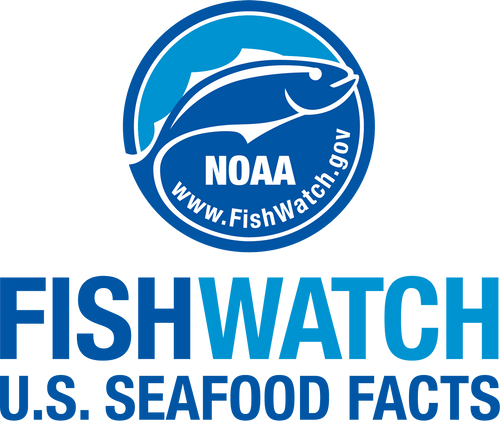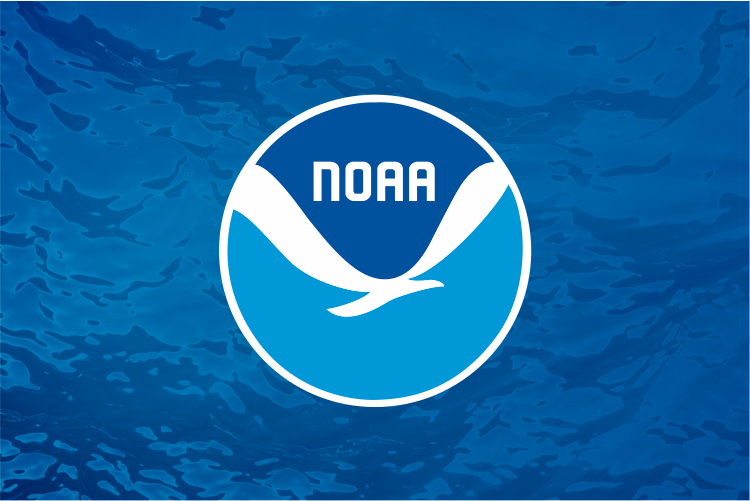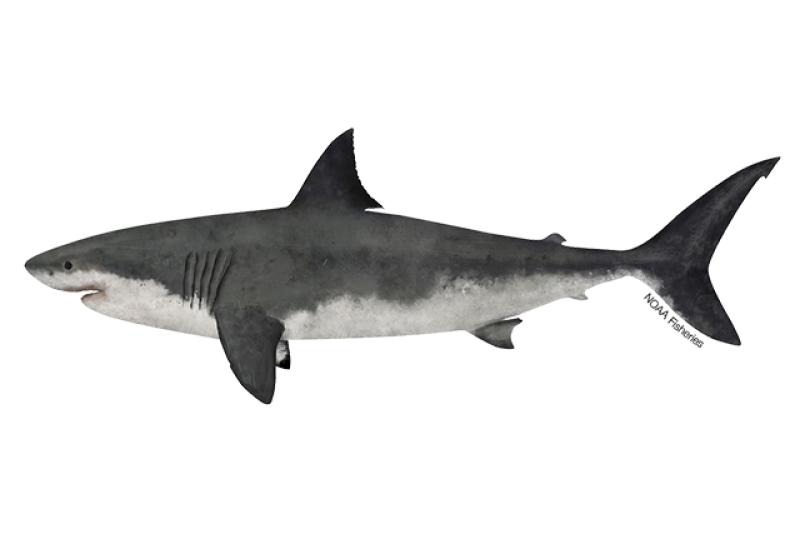 Mako shark. Credit: NOAA Fisheries
Mako shark. Credit: NOAA Fisheries
Mako shark. Credit: NOAA Fisheries
About the Species
 Mako shark. Credit: NOAA Fisheries
Mako shark. Credit: NOAA Fisheries
Mako shark. Credit: NOAA Fisheries
U.S. wild-caught Pacific shortfin mako shark is a smart seafood choice because it is sustainably managed and responsibly harvested under U.S. regulations.

Population
The stock is not overfished.

Fishing Rate
Not subject to overfishing.

Habitat Impact
Gear used to catch shortfin mako does not contact the ocean floor, so there is no impact to habitat.

Bycatch
Regulations are in place to minimize bycatch.
Population Status
- According to the 2024 stock assessment, North Pacific shortfin mako shark is not overfished and not subject to overfishing. Summary stock assessment information can be found on Stock SMART.
Appearance
- Shortfin mako sharks have pointed snouts and long gill slits.
- They have dark blue-gray backs, light metallic blue sides, and white undersides.
- Their teeth are conical and pointy and protrude forward from the jaw, making them visible even when their mouth is closed.
- They can be easily confused with the longfin mako shark (Isurus paucus).
Biology
- Shortfin mako sharks grow slowly and can grow up to 12 feet, although average size is 6 to 7 feet.
- They have a long lifespan, and can live up to 30 years.
- They do not reproduce until late in life, when males are about 8 years old and females are around 20 years old.
- They have a 3-year reproductive cycle, including a 15 to 18-month gestation period.
- Eggs are fertilized internally, and develop inside the mother. Pups are born alive, and are fairly large when born.
- They’re aggressive predators and feed near the top of the food chain on squid and pelagic fish (including swordfish, tuna, and other sharks).
- They have very few predators. Larger sharks and killer whales sometimes prey on younger, smaller shortfin makos.
Where They Live
Range
- In the eastern Pacific, they’re found from the Columbia River to Chile.
- Off the West Coast, they’re most common off California.
- In the Indo-Pacific, they are found from East Africa and the Red Sea to Hawaii.
Habitat
- Shortfin mako sharks live near the surface in tropical and temperate oceans.
- Juveniles are common in coastal waters, and adults are primarily found offshore.
- They are highly migratory and capable of swimming long distances across entire oceans.
Fishery Management
- NOAA Fisheries and the Pacific Fishery Management Council manage the Pacific shortfin mako shark fishery on the West Coast.
- Managed under the Fishery Management Plan for U.S. West Coast Fisheries for Highly Migratory Species:
- Permits are required to fish for highly migratory species, including shortfin mako sharks, and fishermen must maintain logbooks documenting their catch.
- Annual commercial harvest guidelines (a general objective for how much can be caught).
- Closed areas protect endangered turtles.
- Fishermen are required to take a training course on safe handling and release of protected species.
- Mandatory placement (about 20 percent coverage) of at-sea observers on commercial drift gillnet vessels to monitor catch, bycatch, and fishing effort.
- Fishing times and areas are tightly managed to reduce the risk of catching protected species, such as sea turtles, whales, and dolphins.
- NOAA Fisheries and the Western Pacific Regional Fishery Management Council manage the Pacific shortfin mako shark fishery in the Pacific Islands.
- Managed under the Fishery Ecosystem Plan for the Pelagic Fisheries of the Western Pacific:
- Entry to this fishery is limited to a maximum of 164 vessels.
- Permits and logbooks are required.
- Observers are required on all Hawaii-based longline vessels.
- NOAA Fisheries vessel monitoring system (VMS) program requires longline boats to be equipped with a satellite transponder that provides real-time vessel position updates and tracks vessel movements.
- Longlines are prohibited in certain areas to protect endangered Hawaiian monk seals and reduce the potential for gear conflicts and localized stock depletion.
- Vessels operating under longline general permits must carry special gear to release incidentally hooked or entangled sea turtles.
- There are no management measures specific to Pacific shortfin mako shark, because in the Western Pacific they’re only harvested incidentally in the longline fishery for swordfish.
- The Shark Conservation Act requires that all sharks, with one exception, be brought to shore with their fins naturally attached.
- Management of highly migratory species, like mako sharks, is complicated because the species migrate thousands of miles across international boundaries and are fished by many nations.
- Two international organizations, the Inter-American Tropical Tuna Commission (IATTC) and the Western and Central Pacific Fisheries Commission (WCPFC), manage highly migratory species, like sharks, internationally.
- No international measures are in place specific to shortfin mako sharks, but both organizations have passed shark conservation and management measures that combat shark finning practices and encourage further research and periodic stock assessment efforts for sharks.
Harvest
- In 2023, commercial landings of Pacific shortfin mako totaled 28,000 pounds and were valued at $30,000 according to the NOAA Fisheries commercial fishing landings database.
- Most shortfin mako harvested come from the Atlantic and Gulf of America (formerly Gulf of Mexico).
- Gear types and bycatch:
- Harvested with drift gillnets off the West Coast and occasionally caught incidentally in longline fisheries for swordfish off Hawaii.
- Drift gillnets can incidentally catch other species, such as ocean sunfish and blue sharks.
- Protected species, such as sperm whales and sea turtles, may be caught as bycatch in drift gillnet fisheries.
- Managers limit where and when drift gillnet fishermen can fish to help prevent bycatch. Logbooks and observer programs help monitor bycatch.
- The California thresher shark gillnet fishery is a Category I fishery, meaning it has frequent incidental mortality or serious injury of marine mammals. Mako sharks may be caught in this fishery.
- NOAA Fisheries works with the federally appointed Pacific Offshore Cetacean Take Reduction Team to develop measures that reduce the impacts of this fishery on certain marine mammals.
- Fishermen must use acoustic devices that emit high-pitched noises to deter marine mammals, and net extenders to increase minimum fishing depth on drift gillnet gear, to protect marine mammals.
- Off Hawaii, gear restrictions and area closures help minimize impacts to sharks, marlins, and protected species that can be caught in longline gear.
- Safe handling techniques help reduce impacts on sea turtles and seabirds caught in the longline fishery in Hawaii.
- Scientists and managers continue to monitor bycatch in these fisheries through logbooks and vessel observer programs.
- Shortfin mako are considered one of the great game fish of the world and are a popular catch in shark tournaments.
- Recreational charter vessel operators must keep logbooks documenting their catch, and there is a limit on the number of mako sharks recreational fishermen can catch.
Scientific Classification
| Kingdom | Animalia |
|---|---|
| Phylum | Chordata |
| Class | Chondrichthyes |
| Order | Lamniformes |
| Family | Lamnidae |
| Genus | Isurus |
| Species | oxyrinchus |
Last updated by NOAA Fisheries on 03/06/2025
Featured News

Global Extinction Risk for Sharks and Rays Is High, United States may Provide Haven
New Research Predicts Effects of Marine Heatwaves on Top Ocean Predators

Mako Shark Tracking off West Coast Reveals “Impressive” Memory and Navigation
Seafood Facts

Is Pacific Shortfin Mako Shark Sustainable?
U.S. wild-caught Pacific shortfin mako shark is a smart seafood choice because it is sustainably managed and responsibly harvested under U.S. regulations.
Availability
Fresh from August to January.
Source
U.S. wild-caught from California and Hawaii.
Taste
Sweet with a full-bodied, meaty taste.
Texture
Soft when raw, firm once cooked.
Color
Fresh, raw meat is an ivory-pink or muddy, reddish color. When cooked it is ivory white.
Health Benefits
High in protein and low in fat, and a good source of niacin, vitamins B6 and B12, phosphorous, and selenium. More information on health and seafood.
Nutrition Facts
Servings: 1; Serving Weight: 100 g (raw); Calories: 130; Protein: 20.98 g; Total Fat: 4.51 g; Total Saturated Fatty Acids: 0.925 g; Carbohydrate: 0 g; Total Sugars: 0 g; Total Dietary Fiber: 0 g; Cholesterol: 51 mg; Selenium: 36.5 mcg; Sodium: 79 mgMore Information
Last updated by NOAA Fisheries on 03/06/2025
Seafood News
 Chef Tyler Hadfield’s Curried Skate Wings with Tomato-Masala Chutney
Chef Tyler Hadfield’s Curried Skate Wings with Tomato-Masala Chutney
Ring In the New Year With These Crowd-Favorite Seafood Recipes
 NOAA Fisheries, in collaboration with Blue Ocean Mariculture, is conducting a multi-year pilot study to evaluate observational methods and tools for studying Hawaiian monk seal behavior. Courtesy of Blue Ocean Mariculture
NOAA Fisheries, in collaboration with Blue Ocean Mariculture, is conducting a multi-year pilot study to evaluate observational methods and tools for studying Hawaiian monk seal behavior. Courtesy of Blue Ocean Mariculture
AI Meets Aquaculture to Study Hawaiian Monk Seal Interactions With Net Pens
 Tonya Wick aboard a fishing vessel at sea in 1998. Photo courtesy of Tonya Wick
Tonya Wick aboard a fishing vessel at sea in 1998. Photo courtesy of Tonya Wick
 Fish on display at the market. Credit: Shutterstock
Fish on display at the market. Credit: Shutterstock
Science Overview
NOAA Fisheries conducts various research activities on the biology, behavior, and population health of Pacific shortfin mako. The results of this research are used to inform management decisions for this species.
For detailed information about stock status, management, assessments, and resource trends, you can search for Pacific shortfin mako, and any other species of interest, using NOAA’s StockSMART web tool.
Pacific Shortfin Mako Shark Research in the Southwest and the Pacific Islands
Researchers at NOAA’s Southwest Fisheries Science Center and Pacific Islands Fisheries Science Center study Pacific sharks to learn more about their biology, distribution, movements, stock structure, and status as well as their vulnerability to fishing pressure. For example, In 2012, scientists released the results of a study analyzing the stomach contents of shortfin mako, blue, and common thresher sharks in the California Current. This information helped researchers characterize differences among the species as well as their roles in the ecosystem.
Last updated by NOAA Fisheries on 03/06/2025
Data & Maps
American Samoa Longline Logbook Reports 2023
Logbook summary reports for the 2023 calendar year.
American Samoa Longline Logbook Reports 2022
Logbook summary reports for the 2022 calendar year.
Hawaii and California Longline Logbook Reports 2022
Logbook summary reports for the 2022 calendar year.
Hawaii and California Longline Logbook Reports 2021
Logbook summary reports for the 2021 calendar year.
Research
Coastal Pelagic and Highly Migratory Species Life History Research in the Pacific
We research the reproductive biology, growth, foraging ecology, and distribution of highly migratory and coastal pelagic species in the northeast Pacific Ocean.
Last updated by NOAA Fisheries on 03/06/2025




